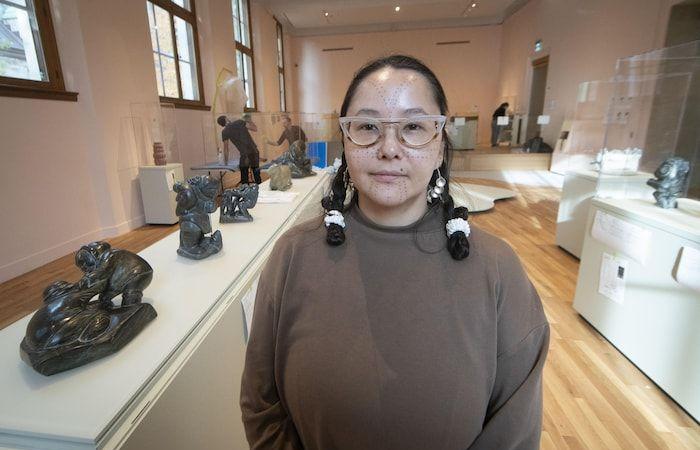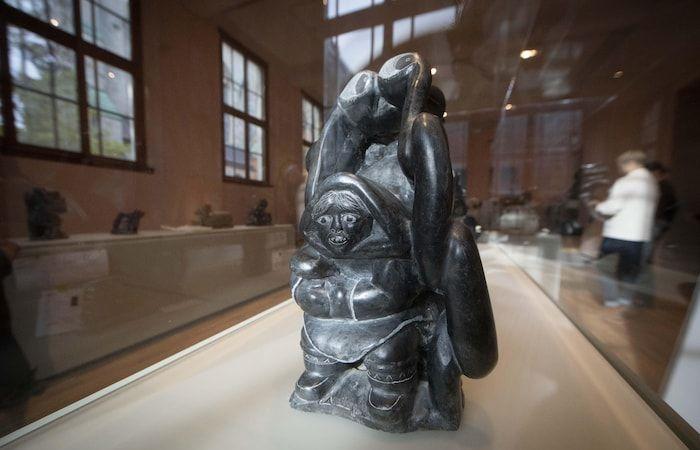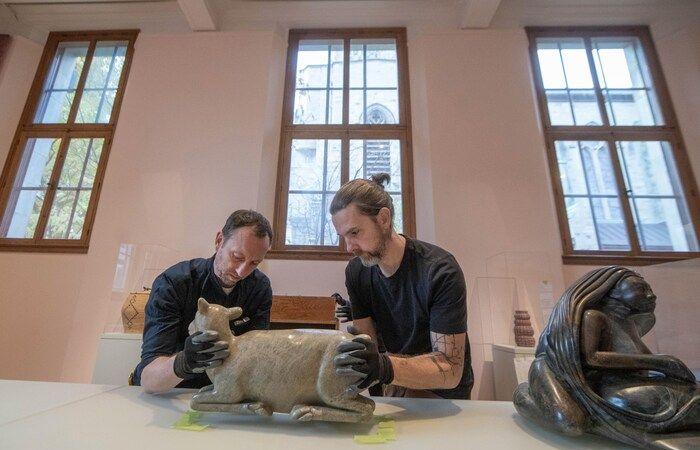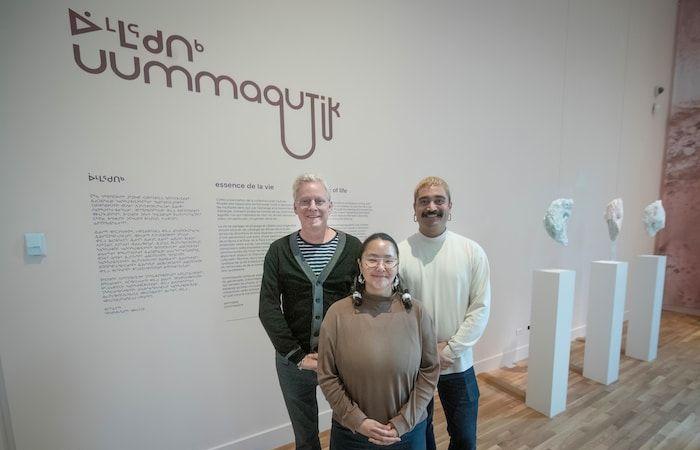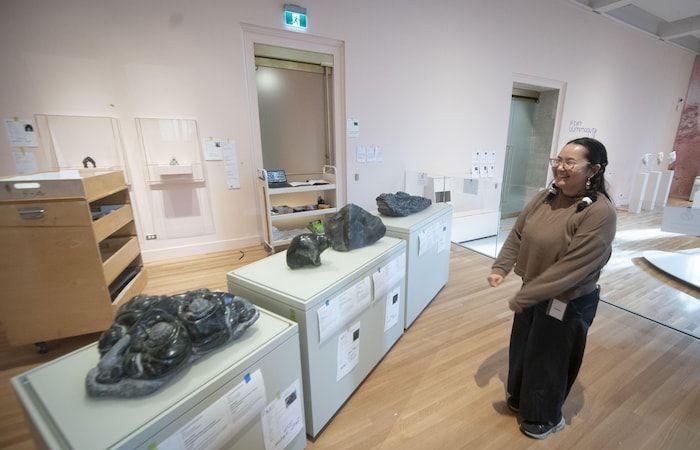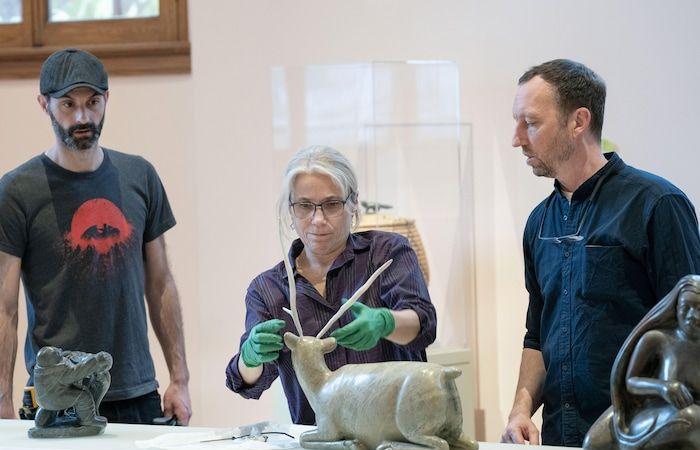What strikes you when entering the gallery called Energy Energy : essence of lifethis is ambient light. A natural light that emanates directly from the large windows on the ground floor of the MMFA inside the magnificent Michal and Renata Hornstein Pavilion.
This is one of the reasons why I am really happy to work in this exceptional piece.
explains the artist and guest curator Asinnajaq in an interview with a smile.
She indicates that the windows in question had been covered by curtains for many years. I definitely wanted light to penetrate the museum space, but it required a lot of work and expertise to make sure the artwork was safe in such a bright environment.
I believe that many of these works have not seen the sun since their acquisition. They will now be bathed in a light that will radically change the way we see them.
Open in full screen mode
Asinnajaq is an artist from Inukjuak in Nunavik.
Photo : - / Ivanoh Demers
That day, in the middle of setting up the gallery, the Inuk curator knew that a unique project was taking shape. The renovated space is gradually revealed under her direction with the installation of works whose shape and structure she observes. There is no coincidence in their arrangement, she emphasizes.
As curator of the exhibition, I try to find balance and harmony between the architecture of the room and the artwork.
In a meticulous ballet, the museum technicians work carefully to install the sculptures which, for the first time, take their place at the heart of a new space dedicated to Inuit art, combining tradition and modernity.
Before they are arranged, I try to understand how the works can communicate with each other. It’s important to listen to works of art and know where and how they want to be seen. I think a lot of it is about listening to yourself.
Open in full screen mode
Over the next five years, the gallery will present some 120 works in rotation.
Photo : - / Ivanoh Demers
An indigenous look at indigenous art
The curator, originally from Inukjuak in Nunavik, herself comes from this culture of the Far North. She acts as a bridge between two worlds: that of Northern artists and that of visitors, whether Aboriginal or not.
I think that art in general and Inuit art in particular is about the interconnection of generations and the opportunity to share knowledge and emotions. I hope that people will take the time to connect with the works and become part of this world, during their visit.
The collection of MMFA brings together the productions of some 300 artists from regions ranging from Alaska to Greenland (Kalaallit Nunaat), including the Canadian circumpolar territories, including Nunavik. Inuit art is an ever-living art that depicts the daily lives of human beings in a cultural environment inhabited by centuries-old ways of thinking.
She specifies that the gallery will be evolving, updated throughout the seasons. Over the next five years, it will present in rotation some 120 works by 70 Inuit artists from Nunavut, Nunavik, Nunatsiavut (self-governing territory of Newfoundland and Labrador) and the Inuvialuit designated regions (Northern Arctic). Western Canada).
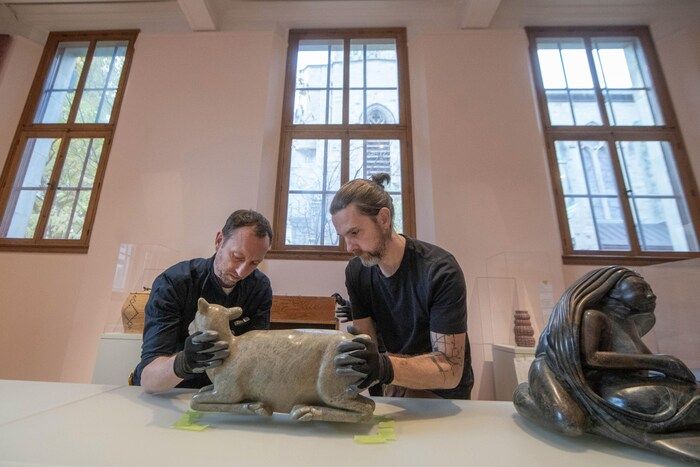
Open in full screen mode
Museum technicians carefully install the sculptures, all under the direction of the curator.
Photo : - / Ivanoh Demers
The space, a true ode to the culture of the first peoples of the north, is also intended to be a mirror of the diversity of contemporary Inuit artistic expressions, she continues. The new spaces totaling more than 200 m2 will double the surface area devoted to the presentation of Inuit art at the Museum.
In addition to sculptures, it brings together prints, drawings, textile works, photographs, paintings and installations
declares the curator who worked closely with Léuli Eshrāghi, curator of indigenous arts at the MMFA and Jacques Des Rochers, senior curator of Quebec and Canadian art.
The latter maintains that the management of the Sherbrooke Street museum had long wanted a space devoted entirely to Inuit art. The gallery is located just at the entrance before the large stairs that lead to the temporary exhibitions. Visitors won’t be able to miss it
he assures.

Open in full screen mode
The curator (center) worked in close collaboration with Léuli Eshrāghi, curator of indigenous arts at the MMFA (right) and Jacques Des Rochers, senior curator of Quebec and Canadian art (left).
Photo : - / Ivanoh Demers
An enriched collection
The institution has also recently enriched its collection with the acquisition of numerous works, particularly in graphic art for which Inuit artists are particularly prolific. The museum now has a collection of very valuable drawings which will have their place in the gallery
stipulates Mr. Des Rochers.
For her part, curator Asinnajaq mentions the presence of unique works presented for the first time to the public, such as the detailed sculpture by Charlie Alakkariallak Inukpuk, placed at the entrance to the gallery.
Look at the finesse of this work, it’s truly masterful
she says, pointing at her. It illustrates a group of women sewing seal skins on an umiaq, a type of traditional boat of Arctic populations.

Open in full screen mode
Asinnajaq observes the Inuit sculptures displayed in the gallery.
Photo : - / Ivanoh Demers
There is also that of Lucassie Echalook, an artist who devotes his career to the representation of traditional Inuit knowledge, in this case, four women covering a kayak (qajaq in Inuit) with seal skin. These artists establish a real dialogue with the ancestors. Each work of art tells its own story. It has its own soul and its own reason for being.
The curator’s personal vision is illustrated in the cartels, these labels or notices that are generally found next to the works exhibited in a museum allowing their identification, as well as their author. Asinnajaq took care to write them in a way different from museum tradition.
I want it to be poetic. I don’t want to say too much about the artwork or explain how it was made. On the contrary, I wish to offer reflections that offer visitors the opportunity to think differently
she said.
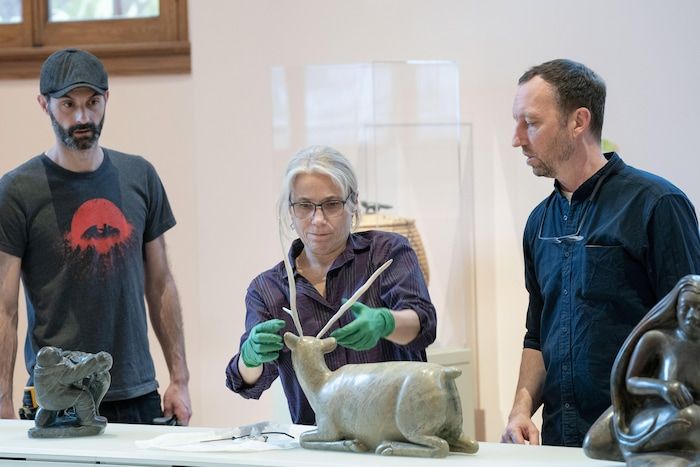
Open in full screen mode
Museum technicians carefully install the sculptures, all under the direction of the curator.
Photo : - / Ivanoh Demers
She recalls that the Inuit works of MMFA were previously located on the 4th floor in the Quebec and Canadian art pavilion. Their decompartmentalization coincides with the desire to put the spotlight on Nordic cultural heritage, often misunderstood or marginalized, maintains the commissioner.
One of the objectives of this gallery is to open eyes to the richness and diversity of Inuit art, beyond the clichés
she concludes.
The doors of the gallery dedicated to Inuit art MMFA will be open to the public from November 8.

